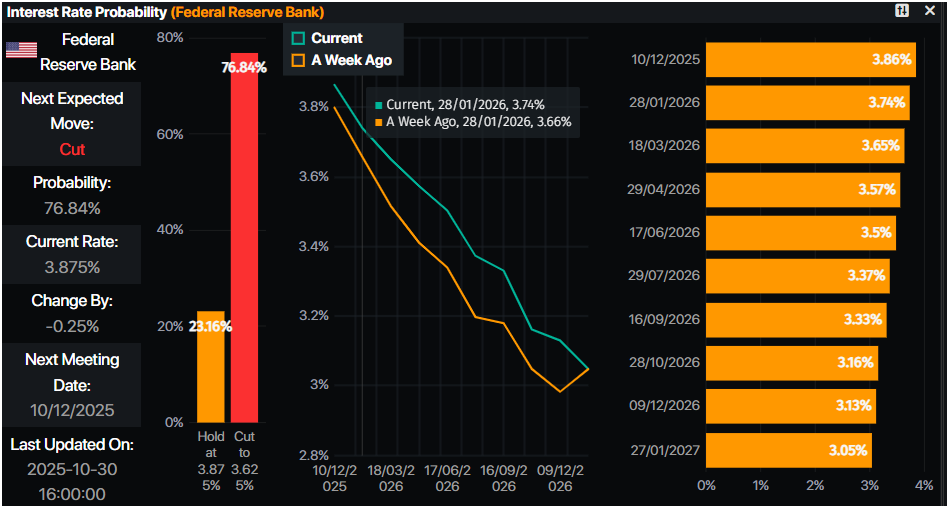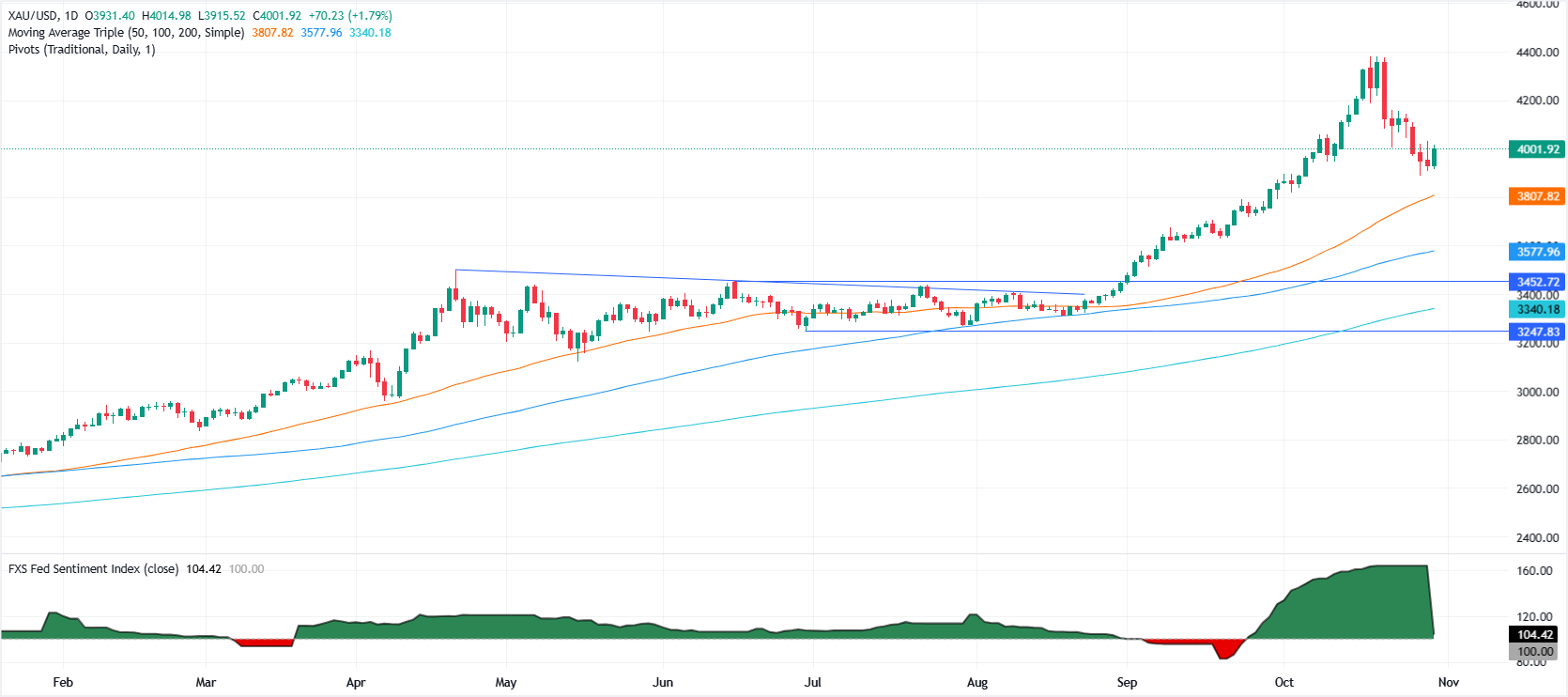Created
: 2025.10.31













![]() 2025.10.31 02:51
2025.10.31 02:51
Gold price rallies over than 1.50% on Thursday after the Federal Reserve (Fed) reduced rates as expected despite Chair Jerome Powell's hawkish comments at the press conference. Falling US Treasury yields and geopolitics boosted the yellow metal, which trades at $3,995 at the time of writing.
On Wednesday, the Fed reduced borrowing costs by 25 basis points to 3.75%-4% on a 10-2 split vote. The two dissenters were Fed Governor Stephen Miran, voting for a 50-bps cut, and Kansas City Fed President Jeffrey Schmid, who opted to keep rates unchanged.
At the press conference, the Fed Chair Jerome Powell surprised the markets, saying "a further reduction in the policy rate at the December meeting is not a foregone conclusion -- far from it." This headline sent waves on Gold prices, which tumbled under $3,920, before recovering, on Thursday throughout the Asian and European sessions.
Powell added that the Fed's main concern is the labor market, but also expressed that, despite lacking official data, the FOMC collected state unemployment claims and said that the jobs market is not deteriorating sharply.
He noted that some members of the FOMC see rates at a neutral stance or closer to neutral.
Bullion's advance could be capped by US-China trade news after both Presidents, Trump and Xi Jinping, met in South Korea for a couple of hours, agreeing to strike a one-year trade truce.

Source: Prime Market Terminal
Gold's technical outlook remains constructive, though buyers need a daily close above $4,000 to sustain bullish momentum and set up a test of the 20-day Simple Moving Average (SMA) at $4,079.
The Relative Strength Index (RSI) shows buyers regaining strength, suggesting further short-term upside potential.
A break above the 20-day SMA would expose resistance at $4,100, followed by the October 22 peak at $4,161. On the downside, a daily close below $4,000 would open the door for deeper losses toward the October 28 low at $3,886 and the 50-day SMA near $3,779.

Gold has played a key role in human's history as it has been widely used as a store of value and medium of exchange. Currently, apart from its shine and usage for jewelry, the precious metal is widely seen as a safe-haven asset, meaning that it is considered a good investment during turbulent times. Gold is also widely seen as a hedge against inflation and against depreciating currencies as it doesn't rely on any specific issuer or government.
Central banks are the biggest Gold holders. In their aim to support their currencies in turbulent times, central banks tend to diversify their reserves and buy Gold to improve the perceived strength of the economy and the currency. High Gold reserves can be a source of trust for a country's solvency. Central banks added 1,136 tonnes of Gold worth around $70 billion to their reserves in 2022, according to data from the World Gold Council. This is the highest yearly purchase since records began. Central banks from emerging economies such as China, India and Turkey are quickly increasing their Gold reserves.
Gold has an inverse correlation with the US Dollar and US Treasuries, which are both major reserve and safe-haven assets. When the Dollar depreciates, Gold tends to rise, enabling investors and central banks to diversify their assets in turbulent times. Gold is also inversely correlated with risk assets. A rally in the stock market tends to weaken Gold price, while sell-offs in riskier markets tend to favor the precious metal.
The price can move due to a wide range of factors. Geopolitical instability or fears of a deep recession can quickly make Gold price escalate due to its safe-haven status. As a yield-less asset, Gold tends to rise with lower interest rates, while higher cost of money usually weighs down on the yellow metal. Still, most moves depend on how the US Dollar (USD) behaves as the asset is priced in dollars (XAU/USD). A strong Dollar tends to keep the price of Gold controlled, whereas a weaker Dollar is likely to push Gold prices up.
![]()
Created
: 2025.10.31
![]()
Last updated
: 2025.10.31

FXStreet is a forex information website, delivering market analysis and news articles 24/7.
It features a number of articles contributed by well-known analysts, in addition to the ones by its editorial team.
Founded in 2000 by Francesc Riverola, a Spanish economist, it has grown to become a world-renowned information website.
We hope you find this article useful. Any comments or suggestions will be greatly appreciated.
We are also looking for writers with extensive experience in forex and crypto to join us.
please contact us at [email protected].
Disclaimer:
All information and content provided on this website is provided for informational purposes only and is not intended to solicit any investment. Although all efforts are made in order to ensure that the information is correct, no guarantee is provided for the accuracy of any content on this website. Any decision made shall be the responsibility of the investor and Myforex does not take any responsibility whatsoever regarding the use of any information provided herein.
The content provided on this website belongs to Myforex and, where stated, the relevant licensors. All rights are reserved by Myforex and the relevant licensors, and no content of this website, whether in full or in part, shall be copied or displayed elsewhere without the explicit written permission of the relevant copyright holder. If you wish to use any part of the content provided on this website, please ensure that you contact Myforex.
Myforex uses cookies to improve the convenience and functionality of this website. This website may include cookies not only by us but also by third parties (advertisers, log analysts, etc.) for the purpose of tracking the activities of users. Cookie policy